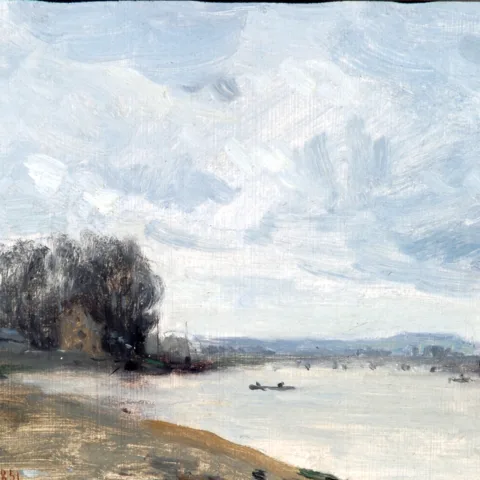The Bowes Museum Blog

Game of Thrones: Medieval Style
One of the pleasures of being a curator of decorative arts is that you often approach or see things differently from other art curators. So, when colleagues here and elsewhere might admire a picture for its handling or style, I’m often thinking: ‘That’s an unusual vase in the background’ or ‘The chair s/he is sitting on doesn’t make sense’.
Apart from the ‘issues’ of the painting of the decorative items in the work of Edouard Manet, who, more than any painter I know, interposes unusual or provocative details into his paintings that must have had meaning to his contemporaries, but which are missed by a modern audience. Most details in painted pictures are alarmingly vague and imprecise, suggesting the artist cared less about a realistic depiction of objects than the people portrayed.
This is a case in point with our wonderful, newly acquired painting by Dieric Bouts, ‘St. Luke Drawing the Virgin and Child’.

‘St Luke Drawing the Virgin and Child’ by the Workshop of Dieric Bouts (The Bowes Museum)
The subject is well known in medieval art, and depends on a composition by Rogier van der Weyden in the Museum of Fine Arts in Boston.

‘St Luke Drawing the Virgin’ by Rogier van der Weyden (©Bridgeman Images)
Van der Weyden in turn took his composition from a painting by Jan Van Eyck in the Louvre of the ‘Madonna with the Chancellor Rolin’.

‘Madonna with the Chancellor Rolin’ by Jan van Eyck (©Bridgeman Images)
I am fairly sure that architectural historians would query the actual existence of the loggia, or balcony, overlooking the city in all three paintings, though clearly such a structure would have been built if a wealthy patron had really demanded one.
The floor tiles look to me alarmingly like Minton ceramic floor tiles of the 19th century, but thankfully our painting has a provenance going back to 1445 so they must be stones of coloured marble, appropriate to the dwelling of the high ranking lady depicted on the left. She appears to be dressed relatively simply for the Queen of Heaven – no doubt acknowledgement of her lowly born status – but what on earth is the chair she is sitting on, with its strange curving X shaped formation?
It would be lovely to be able to do a survey of medieval furniture and ‘place’ it within a certain type or genre, but so little survives of such objects that modern specialists have to refer to medieval painting to get a sense of what it might have been like. Most obviously, in the work of the founder of the Netherlandish school, Robert Campin, whose paintings in the Prado show semi-convincing carpenter made wooden furniture. However, the Virgin and Child being portrayed by Dieric Bouts sit, not in a square hewn carpenter’s chair that might have been produced in the 15th century, but in a very strange, x-framed chair that looks as if it has come out of a Hollywood props department.
A visit to the Scottish National Gallery one day brought me face to face with another medieval painting by Lorenzo Monaco entitled ‘Madonna and Child’, produced in the same century but in a different land (Italy), where the Virgin is shown in a not dissimilar chair with lion’s heads.
The informative caption told me that this was probably based on the Throne of Solomon, and indeed a reference to the Bible tells us that it was ‘two lions standing beside the arms’ (represented as finials). It reminded me of a similar decorative feature in one of the few known surviving medieval chairs, the Throne of Dagobert in Paris.
Our chair does not have the lion’s heads, but there are enough similarities to suggest that the artist has consciously tried to recreate a chair suitable to the Queen of Heaven.
Some x framed chairs which were developed from the 16th century onwards can be folding, but as far as I know the actual folding medieval chair identified today is the famous ‘Glastonbury’ chair, which was much copied in the 19th century (ref).
The x shape seemed to be identified with thrones or ceremonial chairs in the 16th century, for instance the chair at Longford Castle or the royal chair of James I at Knole. This was copied by the firm of Morris and Company for the coronation chairs of George V and Queen Mary in 1911 (Diane Waggoner, ‘William Morris and the Art of Design’ 2014, p.61).
My guess is that the artist did not have a similar chair in front of him, and indeed had probably never seen anything like it, but he knew of biblical chairs from the church teachings and other religious paintings, and decided this was appropriate to his depiction of the Madonna in his.
Come the 19th century, the Pre-Raphaelites, centering on Rossetti and Burne Jones, created imaginary medieval chairs in their paintings that came to be and actually sold by William Morris and Company and other makers. But that is another story…
By Dr Howard Coutts, Keeper of Ceramics







